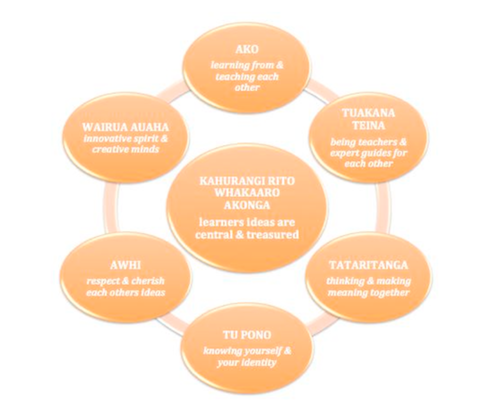Kahurangi rito whakaaro akonga diagram

Visual arts diagram
Background to the Kahurangi rito whakaaro akonga diagram
This diagram synthesises my learning about and understanding to date of
Te Kotahitanga,
He Kakano, inquiry and constructivist learning approaches,
school values and charter,
key competencies, the
New Zealand Curriculum, and student’s classroom interactions, specific to my teaching context. This diagram or model is a work in progress, though senior students used it as a
self-evaluation activity and found it made sense to them.
Kahurangi can mean precious or treasured, and is also the name of a type of pounamu or greenstone - Westland is the ‘home’ of pounamu in New Zealand.
Akonga can mean students or learners, rito can mean central, and also refers to the new or undeveloped shoots at the centre of the harakeke plant, important to the plant's future growth, that grows abundantly in Westland.
Whakaaro refers to ideas, to think, plan, decide, understand, an intention, and also a gift. Within this model, students and their developing ideas are valued and central in senior visual arts classes.
This is different from having students at the centre of learning, and challenges me, the teacher, to work out teaching strategies that move towards increasing levels of student ownership and empowerment.
Activity: Students and their ideas are at the centre of creative knowledge building in our visual arts class community
Six elements that create an effective learning environment.
Self evaluation: Tick the aspects that you have explored so far in art.
Aim to practice all aspects of each element to be an effective community member.
- Ako - learning from and teaching each other
- Shared your ideas with another student.
- Helped solve another’s art problems.
- Asked other students for their opinions.
- Contributed your opinion when asked for it.
- Wairua Auaha - innovative spirit and creative minds
- Work creatively with your own ideas.
- Aim to always improve on your ideas.
- Reflected on your art ideas to refine them and make them better.
- Aim to always improve your NCEA results.
- Tuakana Teina - being teachers and expert guides for each other
- Taught an art technique to another student.
- Got inspired by another’s ideas.
- Worked on your art outside school hours.
- Used “Art Whs” Facebook community.
- Awhi - respect and cherish each other’s ideas
- Know that everyone has different art ideas.
- Feel confident to take risks and try new ideas.
- View exemplars to understand how to improve your art ideas and art work.
- Exhibited your folio artwork and visited the exhibition to see other’s work.
- Tataritanga - thinking and making meaning together
- Explored the work of NZ, Māori and international artists to understand your own ideas better and improve your NCEA results.
- Felt motivated to plan and complete your artwork independently of the teacher, using others for support and encouragement.
- Made an effort to know what art ideas others in the class are exploring.
- Completed all internal and external assessments to maximise your own learning.
- Tu Pono - knowing yourself and your identity
- Made art about things important to you.
- Make art about things you really care about.
- Developed greater confidence in your personal ideas through your art making.
- Take full responsibility for your attendance, work ethic, and art ideas and know that these things contribute to a ‘healthy’, motivated art class community.
Last updated March 26, 2018
TOP


